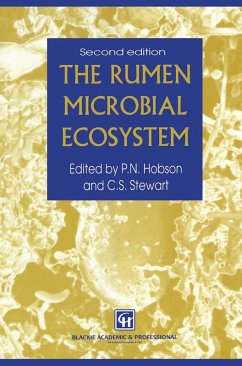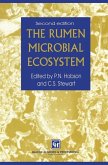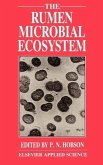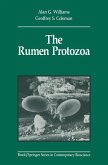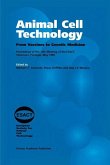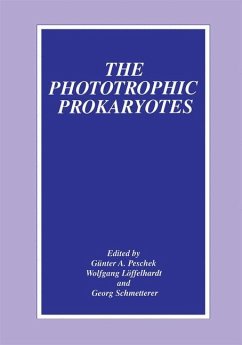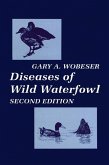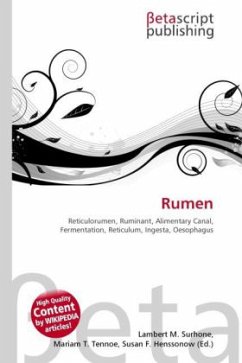The Rumen Microbial Ecosystem
Herausgegeben:Hobson, P. N.; Stewart, C. S.
The Rumen Microbial Ecosystem
Herausgegeben:Hobson, P. N.; Stewart, C. S.
- Broschiertes Buch
- Merkliste
- Auf die Merkliste
- Bewerten Bewerten
- Teilen
- Produkt teilen
- Produkterinnerung
- Produkterinnerung
The Preface to the first edition of this book explained the reasons for the publication of a comprehensive text on the rumen and rumen microbes in 1988. The microbes of the ruminant's forestomach and those in related organs in other animals and birds provide the means by which herbivorous animals can digest and obtain nutriment from vegetation. In turn, humans have relied, and still do rely, on herbivores for much of their food, clothing and motive power. Herbivores also form the food of carnivorous animals and birds in the wild. The importance of the rumen microorganisms is thus apparent.…mehr
Andere Kunden interessierten sich auch für
![The Rumen Microbial Ecosystem The Rumen Microbial Ecosystem]() P.N. Hobson / C.S. Stewart (Hgg.)The Rumen Microbial Ecosystem243,99 €
P.N. Hobson / C.S. Stewart (Hgg.)The Rumen Microbial Ecosystem243,99 €![Rumen Microbial Ecosystem Rumen Microbial Ecosystem]() P.N. Hobson / C.S. Stewart (Hgg.)Rumen Microbial Ecosystem242,99 €
P.N. Hobson / C.S. Stewart (Hgg.)Rumen Microbial Ecosystem242,99 €![The Rumen Protozoa The Rumen Protozoa]() Alan G. WilliamsThe Rumen Protozoa113,99 €
Alan G. WilliamsThe Rumen Protozoa113,99 €![Animal Cell Technology Animal Cell Technology]() Manuel J.T. Carrondo / Bryan Griffiths / Jos‚ L.P. Moreira (Hgg.)Animal Cell Technology243,99 €
Manuel J.T. Carrondo / Bryan Griffiths / Jos‚ L.P. Moreira (Hgg.)Animal Cell Technology243,99 €![The Phototrophic Prokaryotes The Phototrophic Prokaryotes]() PeschekThe Phototrophic Prokaryotes161,99 €
PeschekThe Phototrophic Prokaryotes161,99 €![Diseases of Wild Waterfowl Diseases of Wild Waterfowl]() Gary A. WobeserDiseases of Wild Waterfowl38,99 €
Gary A. WobeserDiseases of Wild Waterfowl38,99 €![Rumen Rumen]() Rumen26,99 €
Rumen26,99 €-
-
-
The Preface to the first edition of this book explained the reasons for the publication of a comprehensive text on the rumen and rumen microbes in 1988. The microbes of the ruminant's forestomach and those in related organs in other animals and birds provide the means by which herbivorous animals can digest and obtain nutriment from vegetation. In turn, humans have relied, and still do rely, on herbivores for much of their food, clothing and motive power. Herbivores also form the food of carnivorous animals and birds in the wild. The importance of the rumen microorganisms is thus apparent. But, while a knowledge of rumen organisms is not strictly neces sary for the normal, practical feeding of farm animals, in recent years there has been much more emphasis on increasing the productivity of domesti cated animals and in rearing farm animals on unusual feedstuffs. Here, a knowledge of the reactions of the rumen flora, and the limits to these reactions, can be invaluable. In addition, anaerobic rumen-type microor ganisms are found in the intestines of omnivores, including humans, and can be implicated in diseases of humans and animals. They are also found in soils and natural waters, where they playa part in causing pollution and also in reducing it, while the same organisms confined in artificial systems are essential for the purification of sewage and other polluting and toxic wastes.
Produktdetails
- Produktdetails
- Verlag: Springer / Springer Netherlands
- Artikelnr. des Verlages: 978-94-010-7149-9
- 2. Aufl.
- Seitenzahl: 744
- Erscheinungstermin: 26. September 2011
- Englisch
- Abmessung: 235mm x 155mm x 40mm
- Gewicht: 1105g
- ISBN-13: 9789401071499
- ISBN-10: 9401071497
- Artikelnr.: 36121258
- Herstellerkennzeichnung Die Herstellerinformationen sind derzeit nicht verfügbar.
- Verlag: Springer / Springer Netherlands
- Artikelnr. des Verlages: 978-94-010-7149-9
- 2. Aufl.
- Seitenzahl: 744
- Erscheinungstermin: 26. September 2011
- Englisch
- Abmessung: 235mm x 155mm x 40mm
- Gewicht: 1105g
- ISBN-13: 9789401071499
- ISBN-10: 9401071497
- Artikelnr.: 36121258
- Herstellerkennzeichnung Die Herstellerinformationen sind derzeit nicht verfügbar.
1 Introduction.- 1.1 Humans and herbivores.- 1.2 The ruminants.- 1.3 The rumen and its development.- 1.4 The functioning rumen.- 1.5 The future.- References.- 2 The rumen bacteria.- 2.1 Substrate specificities of rumen bacteria.- 2.2 Major groups of rumen bacteria.- 2.3 Methods for the isolation, enumeration and cultivation of rumen bacteria.- References.- 3 The rumen protozoa.- 3.1 The entodiniomorphid protozoa.- 3.2 The holotrich protozoa.- 3.3 Interaction of rumen ciliates with other microbial groups in the rumen.- 3.4 The importance of protozoa to the ruminant.- References.- 4 The rumen anaerobic fungi.- 4.1 Taxonomy.- 4.2 Genera and species.- 4.3 Fine structure.- 4.4 Life cycles in vivo.- 4.5 Estimation of population density and biomass.- 4.6 Isolation and culture.- 4.7 Chemical composition.- 4.8 Intermediary metabolism.- 4.9 Fermentation of carbohydrates.- 4.10 Enzymology of lignocellulose catabolism by rumen anaerobic fungi.- 4.11 Nucleic acids of anaerobic fungi.- 4.12 Cloning genes of rumen fungi.- 4.13 Regulation of lignocellulolytic enzyme production in rumen fungi.- 4.14 Attack on plant tissues.- 4.15 Fungal interactions with rumen bacteria.- 4.16 Fungal interactions with rumen protozoa.- 4.17 Transfer between animals.- 4.18 Antibiotic sensitivities.- 4.19 Effects of diet on rumen fungal populations.- 4.20 Conclusions.- Acknowledgement.- References.- 5 Development of, and natural fluctuations in, rumen microbial populations.- 5.1 Rumen ciliate protozoa.- 5.2 Rumen flagellate protozoa.- 5.3 Anaerobic fungi.- 5.4 Rumen bacteria.- 5.5 Interrelationships between rumen microbial populations.- References.- 6 Energy-yielding and energy-consuming reactions.- 6.1 Strategies for rumen microorganisms.- 6.2 Energy-yielding reactions.- 6.3 Energy-consuming reactions.- 6.4 VFAs and low pH.- 6.5 Ionophores.- 6.6 Metabolic regulation.- 6.7 Starvation.- 6.8 Conclusions.- References.- 7 Metabolism of nitrogen-containing compounds.- 7.1 Flow of nitrogenous compounds through the rumen.- 7.2 Breakdown of dietary nitrogenous compounds.- 7.3 Anabolic nitrogen metabolism.- 7.4 Conclusion.- References.- 8 Polysaccharide degradation by rumen microorganisms.- 8.1 Structure and digestion of plant storage polysaccharides.- 8.2 Structure of plant cell walls.- 8.3 Digestion of plant cell walls by rumen microorganisms.- 8.4 Limitations to polysaccharide degradation.- Acknowledgements.- References.- 9 Lipid metabolism in the rumen.- 9.1 Role of microorganisms in ruminant lipid metabolism.- 9.2 Composition of dietary lipids.- 9.3 Hydrolysis of dietary lipids.- 9.4 Biohydrogenation in the rumen.- 9.5 Other lipid transformations.- 9.6 Effect of lipids on rumen fermentation.- 9.7 Composition of microbial lipids.- 9.8 Biosynthesis of microbial lipids.- 9.9 Conclusions.- References.- 10 Genetics of rumen bacteria.- 10.1 Molecular ecology.- 10.2 Mutagenesis in rumen bacteria.- 10.3 Gene and protein structure and expression in rumen bacteria.- 10.4 Gene transfer in rumen bacteria.- 10.5 Conclusions.- References.- 11 Microbe-microbe interactions.- 11.1 Nutritional interactions.- 11.2 Interactions and nitrogen compounds.- 11.3 Carbohydrate fermentation.- 11.4 Amensalistic interactions.- 11.5 Interactions and diversity.- References.- 12 Compartmentation in the rumen.- 12.1 Compartmental models.- 12.2 The rumen simulation technique (Rusitec): a model multicompartment system.- 12.3 The rumen as a multicompartment system.- 12.4 Some consequences of compartmentation in the rumen.- 12.5 Concluding remarks.- References.- 13 Manipulation of ruminal fermentation.- 13.1 Therumen fermentation.- 13.2 The aim in manipulating ruminal fermentation.- 13.3 Modification of the ruminal fermentation pattern.- 13.4 Approaches to modification of ruminal fermentation.- 13.5 Modifiers of ruminal microbial activity.- 13.6 Conclusions.- References.- 14 Digestive disorders and nutritional toxicity.- 14.1 Rumen dysfunctions associated with microbial activities.- 14.2 Neurological dysfunctions associated with microbial activities in the rumen.- 14.3 Microbial transformation.- 14.4 Strategies for addressing toxicity problems in ruminants.- References.- 15 Biological models of the rumen function.- 15.1 Defined bacterial populations without protozoa.- 15.2 The young ruminant.- 15.3 The 'adult' ruminant.- References.- 16 Rumen mathematical modelling.- 16.1 Rumen models.- 16.2 History of fermenter and rumen modelling.- 16.3 Modelling the main digestive events.- 16.4 Aggregation of several digestive events.- 16.5 Whole-rumen models.- 16.6 Conclusions.- References.
1 Introduction.- 1.1 Humans and herbivores.- 1.2 The ruminants.- 1.3 The rumen and its development.- 1.4 The functioning rumen.- 1.5 The future.- References.- 2 The rumen bacteria.- 2.1 Substrate specificities of rumen bacteria.- 2.2 Major groups of rumen bacteria.- 2.3 Methods for the isolation, enumeration and cultivation of rumen bacteria.- References.- 3 The rumen protozoa.- 3.1 The entodiniomorphid protozoa.- 3.2 The holotrich protozoa.- 3.3 Interaction of rumen ciliates with other microbial groups in the rumen.- 3.4 The importance of protozoa to the ruminant.- References.- 4 The rumen anaerobic fungi.- 4.1 Taxonomy.- 4.2 Genera and species.- 4.3 Fine structure.- 4.4 Life cycles in vivo.- 4.5 Estimation of population density and biomass.- 4.6 Isolation and culture.- 4.7 Chemical composition.- 4.8 Intermediary metabolism.- 4.9 Fermentation of carbohydrates.- 4.10 Enzymology of lignocellulose catabolism by rumen anaerobic fungi.- 4.11 Nucleic acids of anaerobic fungi.- 4.12 Cloning genes of rumen fungi.- 4.13 Regulation of lignocellulolytic enzyme production in rumen fungi.- 4.14 Attack on plant tissues.- 4.15 Fungal interactions with rumen bacteria.- 4.16 Fungal interactions with rumen protozoa.- 4.17 Transfer between animals.- 4.18 Antibiotic sensitivities.- 4.19 Effects of diet on rumen fungal populations.- 4.20 Conclusions.- Acknowledgement.- References.- 5 Development of, and natural fluctuations in, rumen microbial populations.- 5.1 Rumen ciliate protozoa.- 5.2 Rumen flagellate protozoa.- 5.3 Anaerobic fungi.- 5.4 Rumen bacteria.- 5.5 Interrelationships between rumen microbial populations.- References.- 6 Energy-yielding and energy-consuming reactions.- 6.1 Strategies for rumen microorganisms.- 6.2 Energy-yielding reactions.- 6.3 Energy-consuming reactions.- 6.4 VFAs and low pH.- 6.5 Ionophores.- 6.6 Metabolic regulation.- 6.7 Starvation.- 6.8 Conclusions.- References.- 7 Metabolism of nitrogen-containing compounds.- 7.1 Flow of nitrogenous compounds through the rumen.- 7.2 Breakdown of dietary nitrogenous compounds.- 7.3 Anabolic nitrogen metabolism.- 7.4 Conclusion.- References.- 8 Polysaccharide degradation by rumen microorganisms.- 8.1 Structure and digestion of plant storage polysaccharides.- 8.2 Structure of plant cell walls.- 8.3 Digestion of plant cell walls by rumen microorganisms.- 8.4 Limitations to polysaccharide degradation.- Acknowledgements.- References.- 9 Lipid metabolism in the rumen.- 9.1 Role of microorganisms in ruminant lipid metabolism.- 9.2 Composition of dietary lipids.- 9.3 Hydrolysis of dietary lipids.- 9.4 Biohydrogenation in the rumen.- 9.5 Other lipid transformations.- 9.6 Effect of lipids on rumen fermentation.- 9.7 Composition of microbial lipids.- 9.8 Biosynthesis of microbial lipids.- 9.9 Conclusions.- References.- 10 Genetics of rumen bacteria.- 10.1 Molecular ecology.- 10.2 Mutagenesis in rumen bacteria.- 10.3 Gene and protein structure and expression in rumen bacteria.- 10.4 Gene transfer in rumen bacteria.- 10.5 Conclusions.- References.- 11 Microbe-microbe interactions.- 11.1 Nutritional interactions.- 11.2 Interactions and nitrogen compounds.- 11.3 Carbohydrate fermentation.- 11.4 Amensalistic interactions.- 11.5 Interactions and diversity.- References.- 12 Compartmentation in the rumen.- 12.1 Compartmental models.- 12.2 The rumen simulation technique (Rusitec): a model multicompartment system.- 12.3 The rumen as a multicompartment system.- 12.4 Some consequences of compartmentation in the rumen.- 12.5 Concluding remarks.- References.- 13 Manipulation of ruminal fermentation.- 13.1 Therumen fermentation.- 13.2 The aim in manipulating ruminal fermentation.- 13.3 Modification of the ruminal fermentation pattern.- 13.4 Approaches to modification of ruminal fermentation.- 13.5 Modifiers of ruminal microbial activity.- 13.6 Conclusions.- References.- 14 Digestive disorders and nutritional toxicity.- 14.1 Rumen dysfunctions associated with microbial activities.- 14.2 Neurological dysfunctions associated with microbial activities in the rumen.- 14.3 Microbial transformation.- 14.4 Strategies for addressing toxicity problems in ruminants.- References.- 15 Biological models of the rumen function.- 15.1 Defined bacterial populations without protozoa.- 15.2 The young ruminant.- 15.3 The 'adult' ruminant.- References.- 16 Rumen mathematical modelling.- 16.1 Rumen models.- 16.2 History of fermenter and rumen modelling.- 16.3 Modelling the main digestive events.- 16.4 Aggregation of several digestive events.- 16.5 Whole-rumen models.- 16.6 Conclusions.- References.

